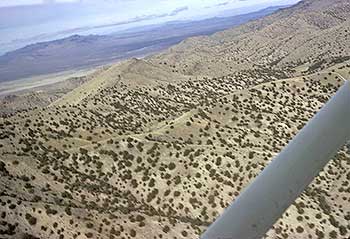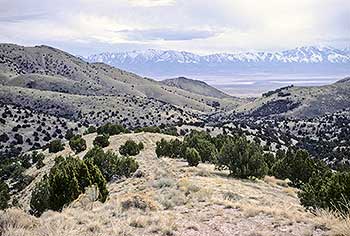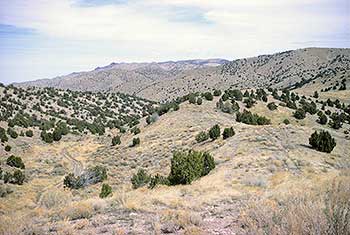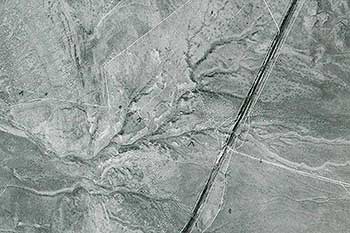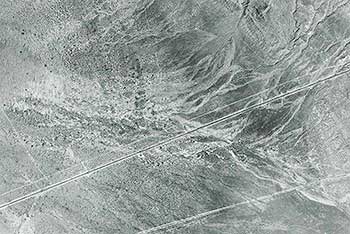| Horseshoe Springs | Redlum Springs | Hastings Pass & Summit | West of Hastings Pass | I-80 | Evaporating Pond |
| Floating Island | Silver Island Point | Bomb Target | Donner Springs | Emigrant Graves | All Photos |
Record your odometer reading before proceeding up the left fork to the west. You will climb a hill until you can see across the ravine on your left. The trail is on the other side by the rock outcropping. Continue on the road from the Delle road 0.9 mile, where it enters the wash or ravine. The trail climbs down into the ravine Just in head and left of you. The trail follows the ravine in the bottom. Proceed up the canyon for 1.0 mile to a faint road on your left. Take this road which will take you around a rock hill and come back into the main road at 0.2 mile. Where the round about road comes back into the main road, look down into the wash on your right and you will see a rock ledge which the emigrants with their wagons would have had to climb over if they came up the main wash. There is no scour marks on the rock ledge that is why the author of this tour feels the emigrants took the round about way.
Continue and look down on your right and you will see the trail. We came up in this canyon after a fire burn in 1995 and noted this distinct trail. Travel 0.6 mile to where the present day road crosses over the trail. At this point the trail begins to climb up the hogsback on our left. Continuing up main canyon the road you will note how steep the canyon becomes and why the trail goes up the less steep hogsback.
Proceed to the summit 0.5 mile from where the trail crosses and take the road on the left. This road follows the ridge and climbs to the summit of the hogsback 0.3 mile where you will see a rail post and plaque. The plaque reads:
"Turning west up each practicable ravine the distance of some six or 7 miles to the top of the ridge, the last two miles of which was up some very steep hills."
Pardon Dexter Tiffany, July 25, 1849
2000 Utah Crossroads Chapter - OCTA HU - 15
MISSING IMAGE: This is the summit of Hastings Pass. The emigrants came up this hogsback to where this rail post is then turned north (left) down from the summit. The photo is looking east across Skull Valley to the Stansbury Mountains and Desert Peak.
Looking down from the summit to the east you will see the pristine trail coming up the hogs back and a great view of Hastings Canyon and Skull Valley to the southeast. Standing on this summit you can imagine the wagons being pulled to this point and the yokes of oxen side stepping on the slope to their right in order to turn the wagons on the top of the hill, then going down this hill to the dugway that was constructed by the lead emigrants companies down into the canyon on the west. You can see the dugway at the bottom of this hill just to the north.
JOHN WOOD tells us about crossing over Hastings Pass:
"About 1 o'clock to-day we started into the field of desolation; for the first fourteen miles we had to travel over a very high and rough mountain, the road over which being so rough and sidling that we had to hold our wagons from upsetting, with ropes. . . . [ probably on the summit and dugway] "
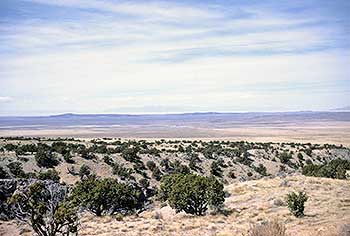 |
| This is the first view the emigrants had of the Great Salt Lake Desert after coming out of Hastings Canyon. |
Because of the mountain tops to the west you have no view of the country ahead.
MISSING IMAGE: This is the dugway coming down from the summit [right center to upper center] of Hastings Pass along the ridge to the left then down a dugway into the canyon.
Turn around as best you can on this narrow ridge and drive back to the main road, and turn left. Record your odometer reading then continue on down the west side for 0.1 mile, this is where the trail meets the road in the canyon from the dugway. Continue on down the canyon for 1.4 miles to where you are opposite the big Aragonite Mine on the right. Aragonite is a water calcium carbonate deposit like the deposits in caverns etc. It was used as a decorative stone and was mined here then hauled down to the Railroad at the now abandoned Aragonite Plant. Continue down the road for 0.3 mile. This is where the Hastings Trail start up over this mountain spur on the right. Drive on around the spur for 0.1 mile to a rail post just above the road on the right.
The plaque on the rail post reads:
"When we go to the foot on the other side we rested our cattle, and took some supper. In an hour we started on our nights journey."
Anonymous, Aug 5, 1850
2000 Utah Crossroads Chapter - OCTA HU - 16
If you look back up the hill you can see the Hastings Trail coming down through the cedars. Turn around and look west. On a clear day Pilot Peak is visible about 60 miles in the distance. Notice Interstate 80 & the Railroad curving over the mud flats. This curve is actually the curvature of the earth. The difference in elevation on the mud flats from Wendover to Knolls is only 5 feet.
Continuing down the road for 0.6 mile, stop and notice the trail depression on the left. This road obliterated most of the trail down to and just beyond the Railroad.
HEINRICH LIENHARD tells about traveling down from Hastings Pass:
"... a boundless flat plain lying before us, an oppressive solitude as silent as the grave. The soil was composed of sand and gravel [Aragonite Road], from which nothing but small, thorny shrubs, grease wood, perhaps 1 l/2 feet high, eked out a miserable existence. Neither wolf nor antelope nor any other animal was to be seen or heard; however, lying scattered over the ground were the bones and gigantic horns of fallen mountain sheep and a few elk. The longer we continued on over the dusty, sandy road down toward the desolate plain, the darker it became. No sound was perceptible except our own muffled footfalls in the loose sand, which had been made unstable by the wagons and the hoofs of the livestock in advance of us. One behind the other, like so many recruits learning to march, we strode along without speaking. . . ."
MISSING IMAGE: Trail depression west of Hastings Pass (in background). There was a fire burn in Hastings Pass and to the west in 1995. This photo was taken on November 22, Looking east, OCTA members Oscar Olson in foreground and Vern Gorzitze in back. Aragonite mining operations destroyed most of trail down to their plant at the railroad n the 1900's. R. Tea.
Continuing our tour, at 1.6 miles you should come to a north-south paved road and on our left is the CLEANHARBORS burn plant. This plant burns toxic waste material such as PCB, paint, etc. Turn right on the asphalt pavement and travel north until you come to a railroad crossing and then at 2.1 miles a frontage road on your left. Turn left on the frontage road and travel 2.3 miles to where the road turns to the south. Across and on the west side of the road is a gate, go through it and pass the pump house and watering troughs, following the vehicle tracks down to the old Victory Highway then turn right on this barely visible road. Follow the road which will turn left then continue on until the road comes into the Hastings trail. Turn left to the berm of the hill by a carsonite marker. Exit the vehicles and look down into the washes where the trail comes across. It appears that the trail across the washes has not been used since it was abandoned after 1850.
Mount the vehicles and turn around then drive west on the south side of the trail. The Victory road used the trail for a short ways then headed directly west to Knolls. The Cutoff Trail after it goes around the rock point, turns to the northwest where it will cross I-80. Since there is no access to I-80 we must turn around and follow the tracks back past the pump building.
The fresh water from this 400 foot deep well is used for the Grassy Mountain Rest Area and is the only good water between Hope Wells and Pilot Springs. Follow the frontage road back to the Burn Plant Road then turn left and drive over the structure and take the west bound on ramp and drive west to the rest area on your right for a needed rest break.
